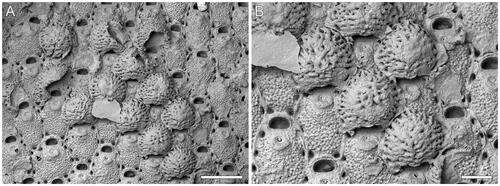Figures & data
Table 1. Measurements in µm of Microporella incurvata sp. nov.
Table 2. Measurements in µm of Microporella gladirostra sp. nov.
Table 3. Measurements in µm of Microporella whiterocki sp. nov.
Table 4. Measurements in µm of Microporella sp. A.
Figure 1. Microporella incurvata sp. nov. A, B, Holotype GNS BZ 342 Miocene (Altonian = Burdigalian), Clifden Limestone Formation, Clifden Quarry, Southland, New Zealand. A, Group of autozooids, some ovicellate (scale bar = 500 µm); B, close-up of orifice, showing four distolateral oral spines, cribrate ascopore and avicularium with bent crossbar (scale bar = 50 µm); C–E, Paratype GNS BZ 343, same details as holotype. C, Group of autozooids (scale bar = 500 µm); D, close-up of orifice and avicularium (scale bar = 50 µm); E, close-up of ovicellate zooids (scale bar = 200 µm). F, Paratype GNS BZ 344, Miocene (Otaian = Aquitanian or Burdigalian), White Rock Limestone Formation, White Rock Limestone Quarry, Karetu River, North Canterbury, New Zealand. Group of ovicellate zooids (scale bar = 500 µm).
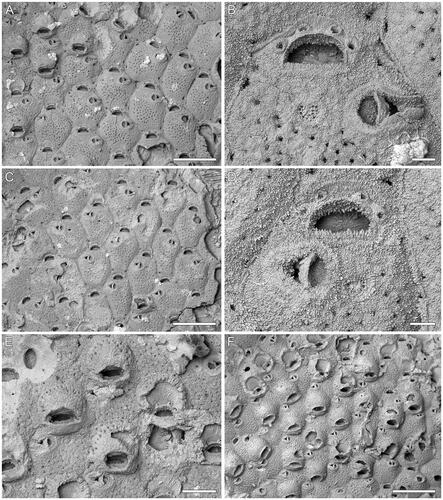
Figure 2. Microporella gladirostra sp. nov. A–D, Holotype GNS BZ 345, Miocene (Otaian = Aquitanian or Burdigalian), White Rock Limestone Formation, White Rock Limestone Quarry, Karetu River, North Canterbury, New Zealand. A, B, Groups of autozooids, some ovicellate, with most commonly four and exceptionally five (see black asterisks in A) and six (see white asterisk in A) oral spine bases (scale bars = 500 µm). Asterisks in B indicate zooids with pores in the proximal peristome. C, Close-up of autozooids, two of which with complete ooecium. The zooid in the centre shows an avicularium with the long, slender rostrum preserved, while the zooid on the bottom right (see asterisk) shows an intramural budded avicularium (scale bar = 200 µm). D, Close-up of ovicell and avicularium (scale bar = 100 µm). E, F, Paratype GNS BZ 346, same details as holotype. E, Close-up of ascopore, orifice with four oral spine bases and avicularium (scale bar = 100 µm); F, close-up of an orifice showing the smooth proximal margin (scale bar = 50 µm).
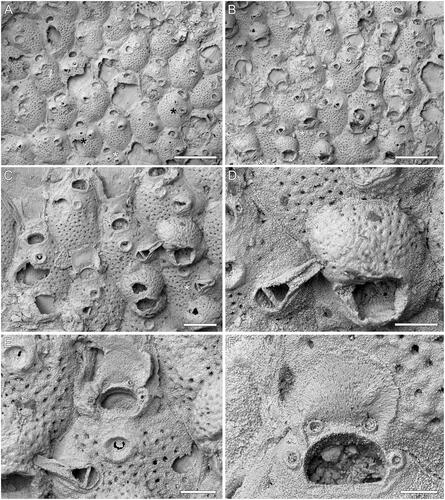
Figure 3. Microporella whiterocki sp. nov. A–C, Holotype GNS BZ 347, Miocene (Otaian = Aquitanian or Burdigalian), White Rock Limestone Formation, White Rock Limestone Quarry, Karetu River, North Canterbury, New Zealand. A, B, Group of autozooids, those at the colony growth edge showing basal pore-chamber windows (scale bars = 500 µm); C, close-up of autozooids showing six oral spine bases and drop-shaped avicularia (scale bar = 100 µm). D, Paratype GNS BZ 348, same details as holotype. Close-up of ovicellate zooids, only one ooecium complete (scale bar = 100 µm).
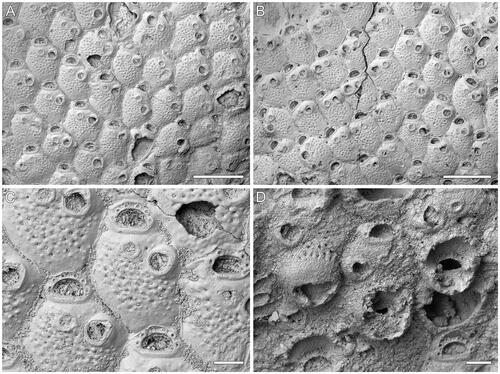
Figure 4. Microporella sp. A. GNS BZ 349, Miocene (Altonian = Burdigalian), Forest Hill Limestone Formation, Lady Barkly Quarry, Southland, New Zealand. A–C, Groups of autozooids from different areas of the colony (scale bars = 500 µm); A, arrows indicate the six distolateral oral spine bases; B, a teratology (top centre), consisting of an autozooid with two avicularia budded on the same side (arrowed); C, a putative kenozooid without openings is present (see asterisk). D, Close-up of two autozooids showing the ascopore (scale bar = 100 µm).
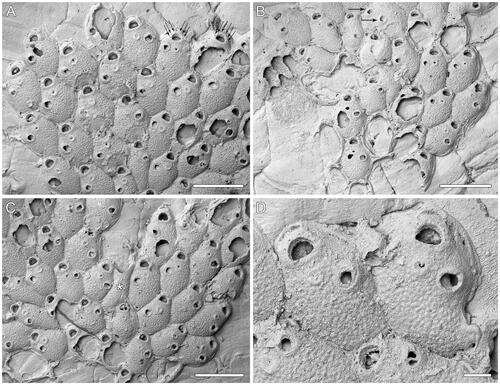
Figure 5. Microporella rusti Di Martino, Taylor, Gordon & Liow, Citation2017, GNS BZ 350, Nukumaruan, Pleistocene, Nukumaru Limestone Formation, Waiinu Beach, North Island, New Zealand. A, Group of autozooids, several ovicellate (scale bar = 500 µm). B, Close-up of ovicells (scale bar = 200 µm).
